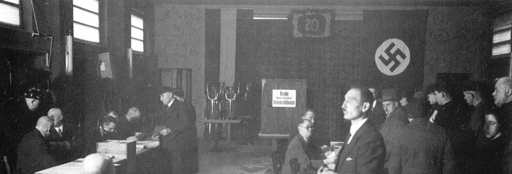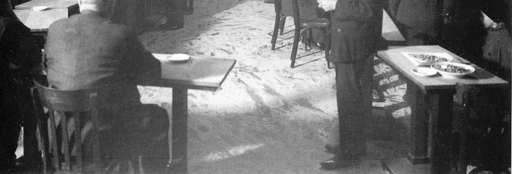Jessen & Richter (Eds.) (69 page)
Read Jessen & Richter (Eds.) Online
Authors: Voting for Hitler,Stalin; Elections Under 20th Century Dictatorships (2011)
poster calling on people to vote. In short, the election is dominating the city.17
Figure 2: Queuing up to vote, Schwarzenbeck, Schleswig-Holstein, November 12, 1933
(Source: Stadtarchiv Schwarzenbek)
On Sunday morning, marching bands from the SA or the Hitler Youth
paraded through the streets and woke up the population: “Get out of bed,
and vote”.18 Open-air concerts made the day feel like a public holiday,
while streets festooned in decorations and public installations served to
create a positive atmosphere. The newspapers urged voters to go to the
polling station early and long queues underlined the feeling of solidarity
and the apparent unity of the
Volksgemeinschaft
.
——————
17
KiZ
, November 11, 1933: “Kiel under the spell of the
Führer
’s speech”.
18 StAHH 614-2/5 NSDAP, circular of the Altona
Kreisleitung
1933-1939, 1941. Circular Nr. 59/34, August 14, 1934.—HC August 20, 1934: “Almost 27,000 people vote in
Neumünster”.

264
F R A N K O M L A N D
People marching in groups to the polling stations—for example, in
1938, the enfranchised Austrians living in the German
Reich
—intensified
the pressure to vote, and made the
Volksgemeinschaft
appear unified. “Every polling station was decorated very carefully. Against a background of dark
green leaves, a picture of our
Volkskanzler
looks down at the voters with a warning gaze”, according to the
Oldesloer Landboten
in 1933.19 The procedures in the polling station were similar to those during the Weimar Re-
public. The
Hamburger Tageblatt
described what happened in November
1933:
There’s a lively atmosphere in the morning at the polling stations, with all the men there working busily. The first handing out the ballot paper with the envelope, the second checking the brown card after the vote has been cast, the third looking up and calling out the number in the electoral register, the fourth supervising people putting their envelope in the ballot box, and the fifth handing out a pin with the word “yes” on.20
And the
Holsteinische Courier
in Neumünster wrote: “On the way to the
polling booth, during the time actually spent in the booth, and on the way
from the booth to the ballot box—this is where the voter had to be left to
himself. The secrecy of the ballot—that simply had to be adhered to”.21
The impression of a
free
election had to be maintained in 1933 at all costs.
“Every act of harassment, especially in front of a polling station, is to be
prevented by all measures available to the police [...] The result of the bal-
lot must not be affected negatively by cases of “election terror”, which
could be used as anti-German propaganda”, according to
Reichsinnenminister
Frick.22 This is what he, as the Party’s election organizer, attempted to
press home to the NSDAP:
Cases have come to light in which NSDAP officials (
Kreisleiter
,
Ortsgruppenleiter
, etc.) have tried to make election committees behave illegally in how they run their election [...] I therefore expressly forbid any NSDAP official to interfere in the election process in a way that could be construed as negatively affecting the right to a secret vote or the freedom to vote or as an unlawful act, and I make the
Gauleiter
personally responsible for ensuring that such cases do not occur in their
Gau
.23
——————
19
OL
, November 13, 1933: “Plebiscite and
Reichstag
election”.
20
HAT
, November 13, 1933: “The Sunday election day in Hamburg”.
21
HC
, November 13, 1933: “Neumünster declares its support for the
Führer
”.
22 LAS 309 / 22574, government decree from November 3, 1933 on the “safeguarding of the election and plebiscite on November 12, 1933”.
23 BarchB R 1501 / 125196, page 282. Letter dated November 7, 1933 to the
Gauleitungen
.



“ G E R M A N Y T O T A L L Y N A T I O N A L S O C I A L I S T ”
265
After voting, voters were given a badge to wear, and this increased the
social pressure on non-voters, who were not able to display the pin. The
only exception was the plebiscite of 1934, when the pin was replaced by a
written note of confirmation. Some of the population gathered in front of
newspaper display windows to find out the interim results, while others
met in pubs and assembly halls to listen to radio broadcasts.
Figure 3: Hamburg, November 1933 (Source: Freie und Hansestadt Hamburg,
Kulturbehörde, Denkmalschutzamt, Bildarchiv)
Deceiving the Voter, Breaking the Secret ballot, Rigging the
Vote
It was not enough for the regime simply to mobilize the population on
election day and to have the electorate register their approval, real and
apparent. Hence, the regime also always manipulated the results in its fa-
vor: in November 1933, for example, envelopes missing ballot papers were

266
F R A N K O M L A N D
counted as abstentions, whereas in March 1933 they had still been counted
as invalid (Omland 2006a, 53–4, 72–3).24 In 1936, Jews were excluded
from elections, as were political
Schutzhäftlinge
in 1938. Also in 1936 vote-rigging became a regular practice:
A ballot paper is not invalid [...] because it has not been filled in. Now that the
Volk
has absorbed the ideas of National Socialism to the point where the replacement of the multi-party system with the single-party state is taken for granted, the ballot paper does not need to be filled out for it to be valid.
In other words, the vote of those who did not put a cross on the ballot
paper should not be counted as “no” or “invalid”, but as “yes”. This was
an official endorsement of vote-rigging, since there were no legal basis for
it and the electorate was not supposed to find out about it: “This should
not be announced publicly, so as to avoid spreading uncertainty amongst
the electorate regarding the method of casting a vote”.25 By 1936 at the
latest, the NSDAP occupied all positions in polling stations, and the
counting of votes gradually took place in complete secrecy.
This enabled the Party not only to rig the vote but also, through their
access to electoral registers and lists of those who had already voted, to
identify and intimidate those who might boycott the election. Rumors that
non-voters could be identified through electoral registers, fear of being
denounced as a non-voter, and open repression from Nazi-activists usually
ensured high election turnouts: the SA’s
Wahlschleppdienst
called on “tardy”
voters in the afternoon and forced them to go to the polling station, and
there is evidence that in 1938 in Reinbek a large crowd shouting “Hang
them!” marched humiliated non-voters to the town hall (Omland 2006a,
179). At the same time, voters could not be sure that the secrecy of ballot
was guaranteed. In Luhnstedt, for instance, a small village in the district of
Rendsburg, the electoral committee sought to identify possible opponents
by giving them marked ballot papers (Omland 2006a, 103).26
As a result of the vote-rigging in the 1936
Reichstag
election, between
two-thirds and three-quarters of all votes against the regime were dis-
——————
24 In Schleswig-Holstein, this made a difference of almost 15,000 votes (1.3 per cent of the number of those entitled to vote), whilst, in some polling stations in Kiel and Lübeck, this made a difference of 19 per cent or 28 per cent.
25 BarchB, R 1501 / 5356, note from 27 March 1936.—LAS 309/22737.
Reichsinnenministerium
to Reg. SL, 27 March 1936.
26 See the correspondence between the lawyer and the
Regierungspräsidium
in the Schleswig state archives 309 / 22738.
